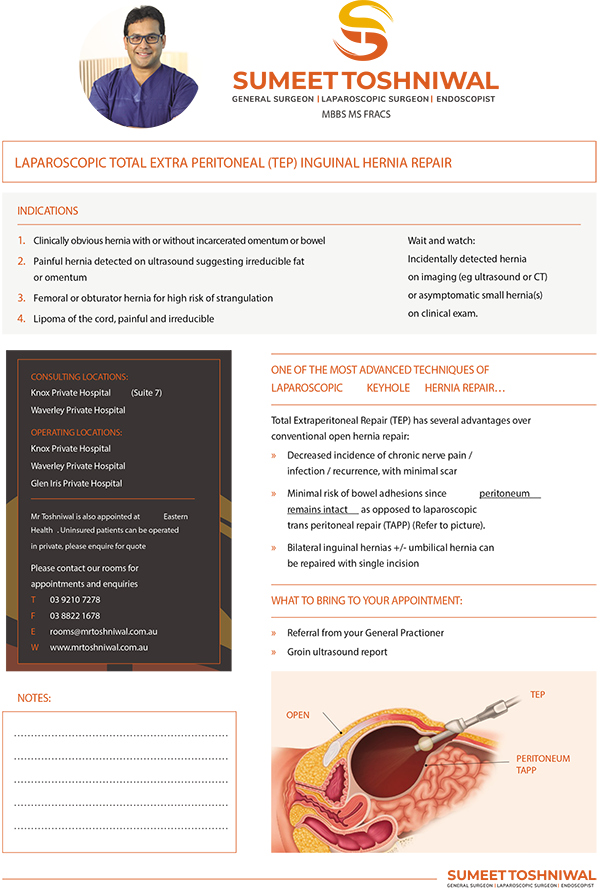Introduction
A hernia occurs when the internal organs of the abdominal cavity push through a weakened spot in the abdominal wall to form a bulge. Hernias occur most commonly between the area of your rib cage and groin.
Hernias may be repaired surgically by closing the defect and using mesh to strengthen the weakened area. This can be performed in a minimally invasive manner using a laparoscope.
Disease Overview
An inguinal hernia is a bulge that forms when a part of your small intestine or fatty tissue protrudes through a weak spot in the groin or into the scrotum or testicular sac.
Hernias generally do not cause any symptoms, but may be discovered on a routine medical exam. Symptoms may include pain, aching, discomfort, or a heaviness in the groin. The bulge formed is more prominent when you stand, cough or strain, and may disappear while lying down as it slips back into the abdomen.
A hernia can sometimes become trapped or strangulated and cannot be pushed back into the abdomen. This is referred to as an irreducible hernia. It is a dangerous situation where the blood supply to the hernia is compromised and may require emergency surgery.
Indications
Small hernias that do not cause any symptoms are usually not treated but instead your doctor may follow a wait-and-watch approach.
Surgery is recommended for hernias that show symptoms, are enlarged or entrapped. Surgery may involve an open hernia repair with a larger incision or laparoscopic surgery, a minimally invasive approach with smaller incisions.
Laparoscopy is especially advised for patients with recurring hernias, bilateral inguinal hernias and femoral hernias. However, it is not recommended for patients with very large hernias, strangulated hernias, prior pelvic surgery and intolerance to general anaesthesia. These would typically require an open approach.
Surgical procedure
Laparoscopic hernia repair is performed under general anaesthesia. Your surgeon will make a few small incisions in your abdomen or groin through which a thin tube called a laparoscope and other special instruments are inserted. A video camera attached to the laparoscope sends magnified images to a monitor guiding your surgeon throughout the procedure. Your surgeon will push the bulge back into the abdomen and either stitch the abdominal wall or use a mesh to support the weakened wall.
Commonly Used Laparoscopic Surgical Techniques For Hernia Repair
TEP and TAPP
A hernia is a sac-like structure that protrudes from a weak area or opening in the wall of the abdominal cavity. It is seen as a bulge over the skin, and often characterised with pain and discomfort. The most commonly used laparoscopic surgical techniques for hernia repair are transabdominal preperitoneal (TAPP) and totally extraperitoneal (TEP) repair.
TAPP repair — this minimally invasive surgical procedure is performed under general anaesthesia. Your surgeon makes a small incision beneath the navel. A needle is inserted through the incision and the abdomen is filled with gas. This allows your surgeon to view the internal organs clearly. The needle is removed and a camera is inserted through the incision. Further, 2 more incisions are made near the navel to introduce the surgical instruments. The peritoneum (a membrane that lines the abdominal cavity) is cut and the hernia sac is removed carefully. A synthetic mesh is placed over the peritoneal opening and then closed with sutures. The disadvantage of the TAPP procedure is it can cause injury to adjacent abdominal organs. The advantage of the TAPP procedure is that it can be performed on patients who have undergone previous lower midline surgery.
TEP repair — this procedure is also performed under general anaesthesia. Your surgeon makes small incisions below the navel. A balloon is placed in the preperitoneal space (space between the peritoneum and anterior abdominal wall) and filled with gas to separate the layers. The camera and the surgical instruments are passed through the incisions. Your surgeon exposes the hernial sac, repositions it and seals the hernia with a synthetic mesh. The incisions are then closed with sutures. The mesh slowly gets incorporated with the tissues of the abdominal wall. The advantage of TEP procedure is that it prevents the risk associated with damage to the internal organs as it is performed outside of the peritoneum.
As with all surgical procedures, TEP and TAPP hernia repair may be associated with certain complications, which include infection, bleeding, swelling and damage to the adjacent organs.
Post-Operative Care
Laparoscopic repair of inguinal or femoral hernia is usually performed as an outpatient procedure so you will return home as soon as you recover from anaesthesia. You may have some swelling or bruising at the incision sites which is normal. Pain and swelling are mostly controlled with medications. It is important to avoid strenuous activity or heavy lifting for at least 2 weeks after the procedure.
Guide to daily activity and exercise following hernia surgery
Discharge Instructions Following Inguinal Hernia Repair
Advantages & Disadvantages
Laparoscopic hernia repair is a minimally invasive procedure and as such is associated with less tissue damage and pain and a faster recovery compared to the open approach. This surgical approach allows you to return home the same day and get back to your regular activities sooner.
Risks and complications
As with any surgery, complications may occur. Complications related to laparoscopic hernia repair include:
- Groin pain due to nerve injury
- Infection at the incision site or mesh
- Blood or fluid accumulation
- Urinary retention
Inguinal hernia information flyer for GPs including indications for inguinal hernia repair:
You will need the Adobe Reader to view and print these documents.


